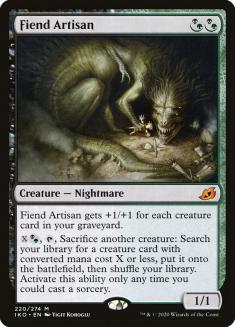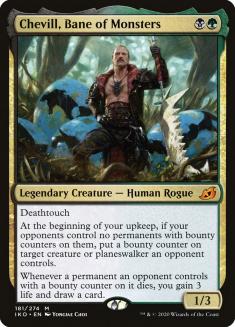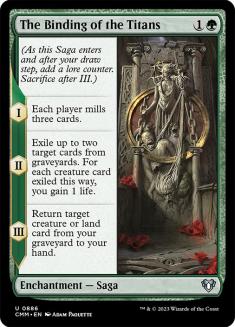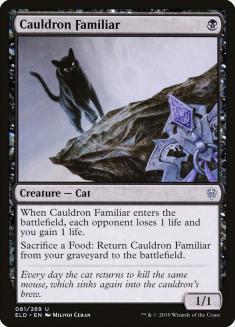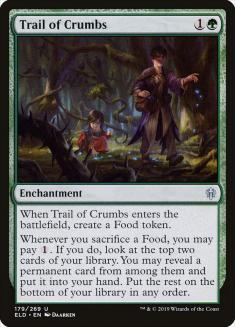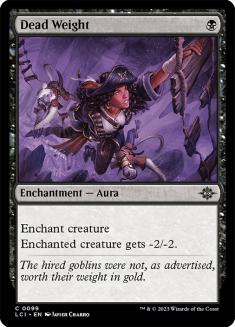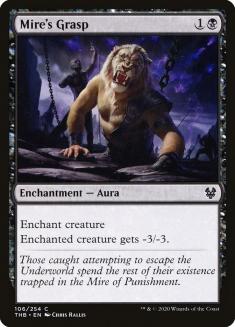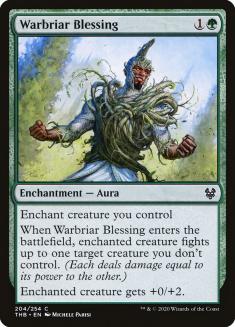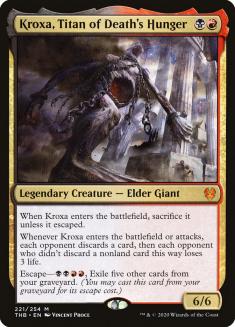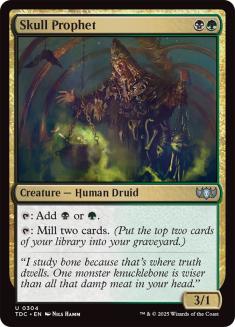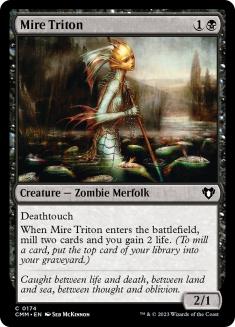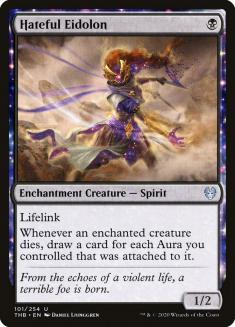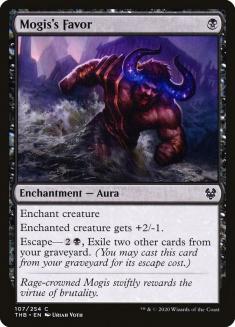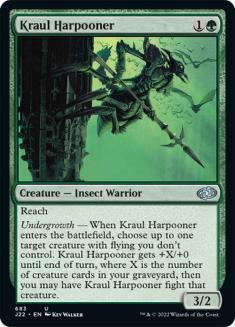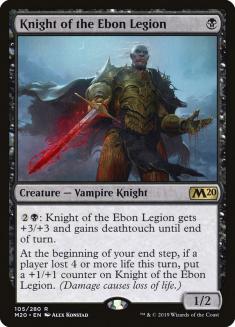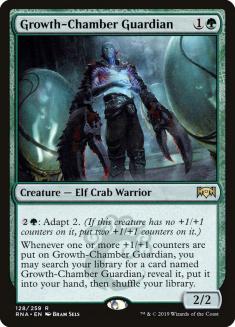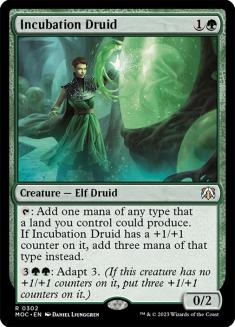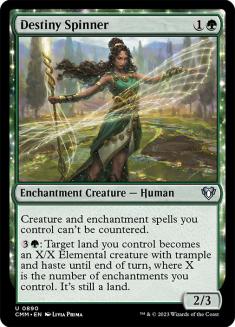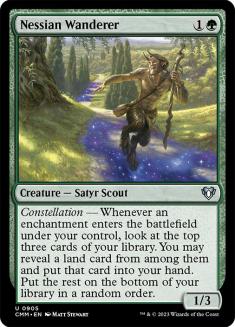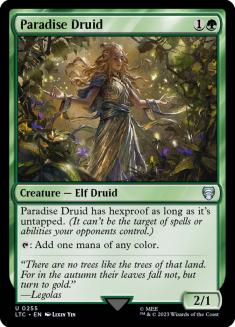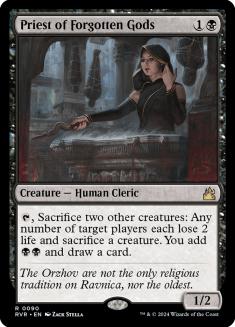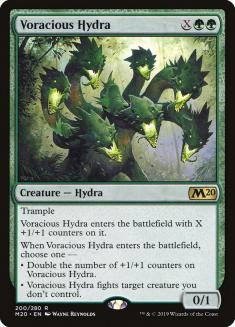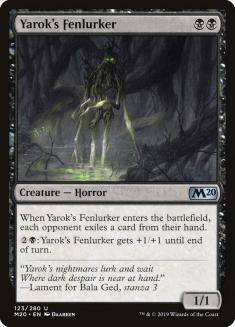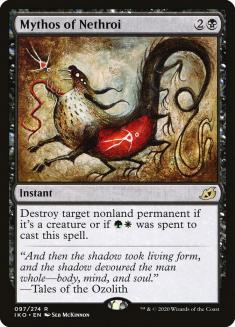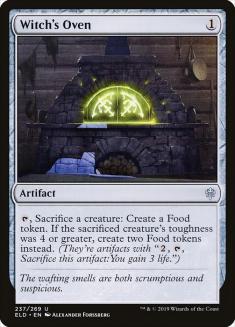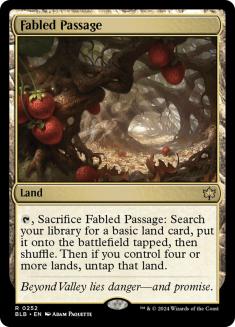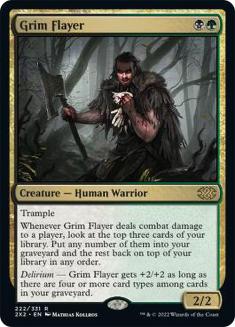Lurrus of the Dream-Den is great. So great that it’s not just a free card in your opening hand, you basically get your best card for free in your opening hand, and you can design your deck around it. But you only get one copy because the restriction means you can’t put more in your deck, and that means it’s really sad when it gets killed, so I like to build my Lurrus decks to allow me to get my Lurrus back.
I realized that The Binding of the Titans is the best way to do this, because it also plays really well when my opponent doesn’t kill my Lurrus, since recasting The Binding of the Titans finds other tools for Lurrus (and brings things back itself and attacks my opponent’s graveyard, which is especially nice against opposing Lurrus decks).
So I wanted to build around Lurrus and The Binding of the Titans.
Companions have gotten most of our attention out of Ikoria because their impact is so over the top, but there are other powerful cards in the set, including multiple strong Golgari mythics that play well with Lurrus.
Fiend Artisan loves cheap creatures and cards that fill our graveyard and bringing back creatures to sacrifice again. It’s the perfect card to add to this shell and also just a ridiculous card in its own right.
Fiend Artisan would like us to have cheap creatures that are good to sacrifice and impactful creatures to find. Lurrus limits our choices with Fiend Artisan, but given that Fiend Artisan requires a lot of mana to find expensive creatures, restricting ourselves to cheap high-impact creatures might not be that bad. Worst case, you can always just find more Fiend Artisans.
These three cards form the core that I want to work with today.
If you have a creature that can return itself from your graveyard to the battlefield, that can fuel Fiend Artisan every turn. As much as I love excessively grindy engines, that might not be a priority — you might want to focus on killing your opponent by attacking rather than activating Fiend Artisan five times, in which case a creature that leaves a single creature behind might give you enough fodder to do what you need to do. Personally, I wouldn’t know about that, and really can’t help myself — I want to be able to keep a chain going.
There are a lot of options when it comes to good creatures to sacrifice. Gutterbones is a great option for going infinitely, but when combined with Fiend Artisan’s mana gating, I think it just gets too expensive.
To my mind, the best option is Cauldron Familiar. Cauldron Familiar asks that we play Witch’s Oven, but I’m pretty happy to do that anyway because I like that it allows me to sacrifice Lurrus if my opponent tries to exile it to make sure my engine can’t be disrupted that easily. Also, while drawing Cauldron Familiar or Witch’s Oven without the other can be a little disappointing, they’re almost always great if we can find both, and with Lurrus and Binding of the Titans, we see a lot more cards and Lurrus can cast Witch’s Oven, so we can assemble the combo a lot more reliably as well as accumulate more Ovens easily.
Cauldron Familiar and Witch’s Oven aren’t mandatory for this kind of strategy, but they’ve proven themselves in general and fit very well into this deck, so I like erring toward including this package.
Cauldron Familiar and Witch’s Oven by themselves don’t actually let us activate Fiend Artisan every turn because in order to return Cauldron Familiar we have to sacrifice a Food, and we generally get that by sacrificing Cauldron Familiar to Witch’s Oven. We can only sacrifice to one or the other, so we’re not there yet. Witch’s Oven tends to result in ending up with some other Food lying around because you sacrifice other creatures that are going to die, but these would certainly be stronger with a little more support. We can take this all one step further — we’re already playing green, so we can extend the Food package into Gilded Goose, a great card that plays well in this deck anyway, and then optionally from there we can also add Trail of Crumbs.
Personally, I think Trail of Crumbs is a great addition to a deck built around cheap permanents, so that sounds like a really good direction to me.
So one promising thread of this deck creation is Lurrus Golgari Food with Lurrus as a companion, Gilded Goose, Cauldron Familiar, Witch’s Oven, Trail of Crumbs, and Fiend Artisan.
I assume we’re going to want some interaction. Dead Weight is fantastic interaction in this deck because it can be found with Trail of Crumbs and returned with Lurrus, and it kills an opposing Lurrus. It only answers small creatures, but I’m not sure how much we need to be able to answer big creatures with our maindeck. Mire’s Grasp lets us go a little bigger, but we could also play a few real removal spells if we have to. If we want to kill bigger things we can even go to Warbriar Blessing, which doesn’t necessarily put itself back in the graveyard, but at least Lurrus lets us cast it if we mill it.
The other card from Ikoria that I’m excited about is Chevill, Bane of Monsters. Chevill isn’t great at damaging players, but it plays really well against creatures on all fronts, and that’s exactly the kind of cheap, high-impact option I’m looking for in my Fiend Artisan deck. I’m not sure how many copies we want, but it’s at least one. From there, it really depends on how any creature decks you expect to face. Also, the more you play the more removal you want, ideally.
There are a few more legendary creatures that also make great high-impact bullets — Tymaret, Chosen from Death and Aphemia, the Cacophony. Tymaret plays really well against opposing Lurrus decks and also gets a lot of toughness with Fiend Artisans, Lurrus, and Cauldron Familiars around. Aphemia helps fuel Fiend Artisan or just attacks our opponent, and we have a good number of enchantments to make it work.
This shell covers most of our deck, with a few open slots for tuning. Some options:
Splash Red for Kroxa, Titan of Death’s Hunger. This is a pretty tough splash that will cost a lot of life, but Kroxa’s great with Lurrus and great with The Binding of the Titans. It’s a tricky tradeoff.
This is a fragile creature that’s very against opposing Dead Weights, but our deck makes good use of extra mana and extra milling, and removal is going to have great options anyway, so it’s pretty reasonable.
Helps buy time, fuel Fiend Artisan, and find pieces to return with Lurrus and stuff — decent cog, slightly low-impact, very good against aggro.
We’re using enchantments for removal and we want enchantments in our graveyard for Aphemia, so this is another cheap, potentially high-impact engine piece we could include.
There’s also the option for more interaction, but the more spells we play, the worse Trail of Crumbs gets. That said, there’s definitely room for some or even more creatures:
You could also splash white or blue. I’m not sure exactly what for but I like a small white splash to fuel Mythos of Nethroi out of the sideboard at the very least, as it allows you to answer both large creatures and opposing Grafidgger’s Cage and Leyline of the Void (I think it’s fine to play but unnecessary in Game 1, but would bring it in against basically every opponent after sideboarding). With blue, Fblthp, the Lost is cute with Fiend Artisan but that doesn’t really feel like what this deck needs.
My current build:
Creatures (20)
- 1 Kraul Harpooner
- 4 Gilded Goose
- 3 Cauldron Familiar
- 2 Aphemia, the Cacophony
- 1 Tymaret, Chosen from Death
- 2 Hateful Eidolon
- 3 Chevill, Bane of Monsters
- 4 Fiend Artisan
Lands (22)
Spells (18)

I mentioned that there could be other threads, but in Standard, I’m not sure what they’d be. You could focus more on self-milling I suppose, particularly if you want to play Kroxa instead of playing Food, but then you’re weaker against strategies that attack your graveyard. I suppose another angle would be to incorporate more Priest of Forgotten Gods-type stuff, but I’m not sure that Golgari is better at doing that than the other combinations that are currently being played. Ultimately, I think this is the correct direction for Standard and I’m optimistic about this deck’s positioning, particularly with the right tuning of the flexible cards and sideboard.
I also think this core has legs in Pioneer, where it gets a lot more tools. The most important addition is Satyr Wayfinder, since Satyr Wayfinder fills your graveyard, is a great creature to sacrifice to Fiend Artisan, and keeps you creature density up for Fiend Artisan.
We could stick with the Food shell, at which point a huge portion of the deck is spoken for, but I have some concerns about the speed of Trail of Crumbs in Pioneer, so let’s explore a different option.
Once you’re playing The Binding of the Titans, it feels like it’s pretty easy to get delirium, so I’m interested in Grim Flayer to push our focus on aggressive, large two-mana threats in a deck that plays more like Modern Golgari.
If we’re playing delirium, we want to pay attention to our types.
Sorcery: Thoughtseize is the easy first four here, though we might want a few more. I think my favorite option is Call of the Death-Dweller, but Gather the Pack and Drown in Filth also work. Without expensive bullets I don’t think I like Traverse the Ulvenwald, but it’s an option.
Instant: I like Mythos of Nethroi and Grisly Salvage the most, but Grapple with the Past is also reasonable, since it gets Lurrus back. If you wanted to play a slightly bigger game, you could also play Once and Future.
Enchantment: The Binding of the Titans, and then supplement with removal. Dead Weight is still good here, but Sinister Concoction is with consideration. Aphemia, Destiny Spinner, and Tymaret also work here, though the’re a little weak for Pioneer — it’s hard to play Tymaret over Scavenging Ooze, for example.
Artifact: Even if we don’t play Trail of Crumbs, we could still play Gilded Goose, Cauldron Familiar, and Witch’s Oven, as Witch’s Oven is a good artifact. Walking Ballista is good with Lurrus, but I think it’s pretty weak. We could also play Mox Amber, especially if we play other legendary creatures in addition to Lurrus.
Land: We should mill lands naturally with Satyr Wayfinder and The Binding of the Titans, but we could play Fabled Passage to help here.
Creature: This deck will be mostly creatures.
Creatures (22)
- 3 Deathrite Shaman
- 4 Satyr Wayfinder
- 4 Grim Flayer
- 4 Gilded Goose
- 2 Cauldron Familiar
- 1 Chevill, Bane of Monsters
- 4 Fiend Artisan
Lands (20)
Spells (18)

Playing and making the most of Deathrite Shaman and Gilded Goose together is very exciting to me, as both cards are great in this kind of deck and have never really had an opportunity to be paired together. This gives the deck a nice mana boost early without playing Elves that are weak in the late-game, and Deathrite Shaman is great against Lurrus decks.
The focus of this deck is Thoughtseize into huge two-mana threats. Like Tarmogoyf, they might take a little while to get going, but the point is that they offer early pressure that not just stays relevant late but likely outclasses much more expensive creatures.
I like to play fewer than four Cauldron Familiars in decks that see a lot of cards because you don’t benefit much from additional copies, and here Fiend Artisan can find one if you need it.
I’m not sure that Grim Flayer is the best threat. Delirium seems pretty easy to get, but this is the only payoff and it’s not really adding something unique to the deck. I like most of the cards I’m playing of different types, but if you didn’t want to play Witch’s Oven, delirium would be a bit harder. If you wanted to skip Food and delirium, you could potentially replace Gilded Goose with Arboreal Grazer and Grim Flayer with Sylvan Advocate but you’d want additional lands, and you’d also want more ways to draw cards to keep hitting your land drops. Without Tireless Tracker, this could be difficult, but it could potentially be solved either with an energy subtheme that uses Glint-Sleeve Siphoner, or by playing more Chevills and Arguel’s Blood Fast.
Let’s take a look at that approach:
Creatures (20)
- 3 Deathrite Shaman
- 4 Satyr Wayfinder
- 4 Sylvan Advocate
- 3 Arboreal Grazer
- 2 Chevill, Bane of Monsters
- 4 Fiend Artisan
Lands (23)
Spells (17)

This deck is very similar to the previous one, with Sylvan Advocate replacing Grim Flayer. Which is better is likely primarily a function of how many Wild Slash– and Stomp-type effects people are playing. Grim Flayer gets big a little faster, but it’s usually going to start small, while Sylvan Advocate’s too big for those out of the gates and only gets bigger.
The Binding of the Titans strongly prefers decks with a high creature density, which means that it and Fiend Artisan go very well together. Because Fiend Artisan and Lurrus are such good mana sinks, I’ve kept the curves of these decks fairly low. Thinking about Arboreal Grazer and Sylvan Advocate, I realize that nothing about Lurrus means your curve has to be low, and this could even be built as a Seasons Past control deck. It’s a bit of a different direction, but as long as I’ve mentioned it, let’s finish off with a look at that:
Creatures (9)
Lands (24)
Spells (27)

I’m a little skeptical about the Arboreal Grazers with only 24 lands, but Nissa’s Pilgrimage helps somewhat with making sure that we don’t just end up missing land drops the next turn, and I think this deck is probably too slow without them. Some balancing might need to shift in terms of number of lands compared to number of ramp spells. I’m also not sure if this deck needs some kind of big finisher card. I’m used to having Tireless Tracker and planeswalkers but we don’t strictly need those, since Seasons Past and Dark Petition can give us unlimited action, but we still might want some kind of giant reset or something.
Perhaps The Great Aurora…



